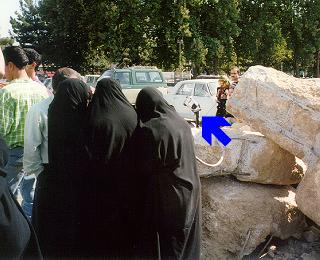
Totality: The Movie

 |
Eclipse 1999 Totality: The Movie |
 |
| by John Walker | ||

 The eclipse videos below were recorded on a Sony DCR-PC1E Mini DV
digital camcorder. This device is certified by its manufacturer as
immune to damage when pointed at the Sun as long as no
auxiliary lenses are mounted. I decided to rely upon and
exploit this feature in my eclipse photography program.
The eclipse videos below were recorded on a Sony DCR-PC1E Mini DV
digital camcorder. This device is certified by its manufacturer as
immune to damage when pointed at the Sun as long as no
auxiliary lenses are mounted. I decided to rely upon and
exploit this feature in my eclipse photography program.
If a camera can handle being aimed at the unobstructed Sun, there's no reason whatsoever to worry about pointing it at the slender crescent a minute or so before or after totality. So that's what I decided to do—preposition the camera so the entire arc of the Sun's apparent motion during the eclipse would be on-screen and forget it until after the end of totality. I'd previously locked out auto-focus, hand-focused to infinity, and zoomed the lens to the maximum optical zoom. To the right is the camcorder, sitting on the rock pile and aimed at the Sun about half an hour before totality. Why are all the people looking away from the Sun? Because they're using the pinhole projection viewers published in the newspaper which were considered safer than the direct vision goggles on sale along the eclipse track. (I tested a number of goggles on sale in Eshafan and found them all to be perfectly safe, but others I didn't encounter might not have been adequate.)
So what did I get? Check out the following movies. While the
camcorder was recording these, I was busy taking in the eclipse
with the unaided eye while snapping slides of the event. Visit the
Eclipse 1999 Photo Gallery
to see the best of the slides.
 Although the Sony camera is designed so pointing it at the Sun does
not cause damage, the intensity of the Sun, even when mostly eclipsed,
far exceeds the autoexposure capability of the camera and results in
completely overexposed images. But a bizarre piece of luck resulted
in the approach of totality's being visible in this movie. The intense light
of the crescent of uneclipsed Sun caused a lens flare
in the camcorder's optics, which superimposed a second dimmer image
(marked by the arrow in this still frame from the half-scale movie)
below the main overexposed image of the Sun. By watching this lens
flare you can observe the shrinking sector of the Sun's disc as
totality approaches. During totality the main image is properly
exposed (albeit at a default setting which shows the outer
corona at the expense of prominence and chromosphere detail
visible in some images in
the still photo gallery).
Although the Sony camera is designed so pointing it at the Sun does
not cause damage, the intensity of the Sun, even when mostly eclipsed,
far exceeds the autoexposure capability of the camera and results in
completely overexposed images. But a bizarre piece of luck resulted
in the approach of totality's being visible in this movie. The intense light
of the crescent of uneclipsed Sun caused a lens flare
in the camcorder's optics, which superimposed a second dimmer image
(marked by the arrow in this still frame from the half-scale movie)
below the main overexposed image of the Sun. By watching this lens
flare you can observe the shrinking sector of the Sun's disc as
totality approaches. During totality the main image is properly
exposed (albeit at a default setting which shows the outer
corona at the expense of prominence and chromosphere detail
visible in some images in
the still photo gallery).
The original video recorded on a Mini DV cassette was transferred to a computer by connecting the S-Video and audio outputs of the camcorder to the corresponding inputs on a Silicon Graphics (now SGI) Indigo² workstation purchased in 1994. The video and audio stream was captured to a hard drive with the mediarecorder utility furnished with the IRIX 6.5 operating system. The raw capture, at PAL resolution (768×576 pixels per frame) and 44.1 kHz stereo audio with 16 bits per sample (CD quality) was in excess of one gigabyte. (The Sony camera has a digital video output in IEEE 1394 “FireWire” format, but my video capture hardware supports only analogue input.)
SGI's moviemaker was then used to extract the individual frames of the movie which were uniformly cropped to a smaller frame encompassing the Sun's arc across the sky for the duration of the video. A second set of frames were prepared for the half scale movie by scaling the original frames by a factor of ½. All format conversion, cropping, and scaling were performed with the pbmplus image processing utilities coordinated by one-off Perl programs.
The cropped and cropped-and-scaled sets of frames were then reassembled into uncompressed full- and half-scale movies with the SGI command-line makemovie utility, incorporating into each a sound track which had been resampled at 22.05 kHz monaural (which saves space and is more than adequate for this video), then the interactive moviemaker was used to compress and encode the resulting movies into QuickTime and MPEG format. The entire process of producing these movies required in excess of 6 gigabytes of hard drive space.